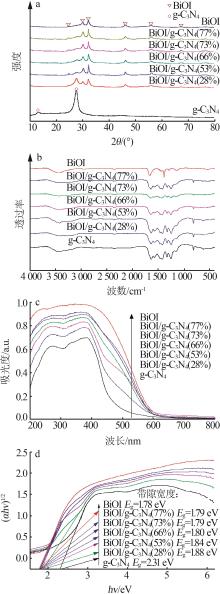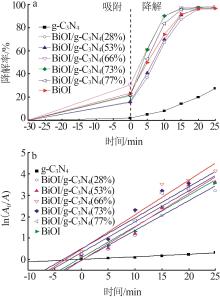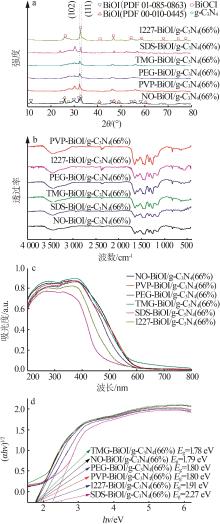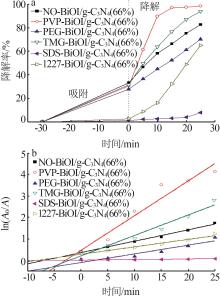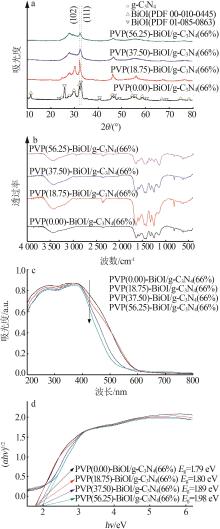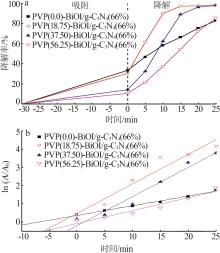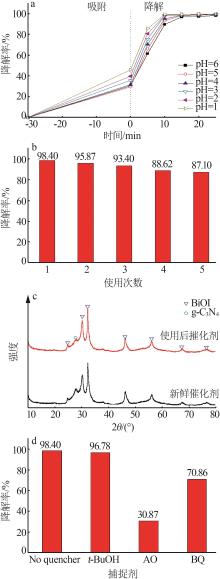Inorganic Chemicals Industry ›› 2023, Vol. 55 ›› Issue (8): 36-44.doi: 10.19964/j.issn.1006-4990.2023-0022
• Application of novel inorganic materials in photocatalysis and electrocatalysis • Previous Articles Next Articles
Preparation of BiOI/g-C3N4 catalyst and its photocatalytic degradation performance of Rhodamine B
SUN Haijie1( ), CHENG Yuan1, TIAN Yuan1, LIU Hongyan1, CHEN Zhihao2(
), CHENG Yuan1, TIAN Yuan1, LIU Hongyan1, CHEN Zhihao2( )
)
- 1.College of Chemistry and Chemical Engineering, Zhengzhou Normal University, Zhengzhou 450044, China
2.Zhengzhou Tobacco Research Institute of CNTC, Zhengzhou 450001, China
-
Received:2023-01-09Online:2023-08-10Published:2023-08-25 -
Contact:CHEN Zhihao E-mail:sunhaijie406@163.com;chenzh@ztri.com.cn
CLC Number:
Cite this article
SUN Haijie, CHENG Yuan, TIAN Yuan, LIU Hongyan, CHEN Zhihao. Preparation of BiOI/g-C3N4 catalyst and its photocatalytic degradation performance of Rhodamine B[J]. Inorganic Chemicals Industry, 2023, 55(8): 36-44.
share this article
| 1 | 陈建军,李永宇,崔天露,等.分级孔结构g-C3N4光催化剂的制备及性能[J].无机化学学报,2020,36(5):835-840. |
| CHEN Jianjun, LI Yongyu, CUI Tianlu,et al.Preparation and properties of g-C3N4 photocatalysts with hierarchical porous structu-re[J].Chinese Journal of Inorganic Chemistry,2020,36(5):835-840. | |
| 2 | 陈建军,李永宇,王雅苹,等.C/g-C3N4/MoS2复合材料的制备及光催化性能[J].无机化学学报,2021,37(5):791-797. |
| CHEN Jianjun, LI Yongyu, WANG Yaping,et al.Preparation and photocatalytic activity of C/g-C3N4/MoS2 composites[J].Chinese Journal of Inorganic Chemistry,2021,37(5):791-797. | |
| 3 | MOHAMMAD A, KHAN M E, CHO M H,et al.Fabrication of binary SnO2/TiO2 nanocomposites under a sonication-assisted appro- |
| ach:Tuning of band-gap and water depollution applications under visible light irradiation[J].Ceramics International,2021,47(11):15073-15081. | |
| 4 | JIA Litao, LI Fanghua, YANG Chenjia,et al.Direct Z-scheme heterojunction α-MnO2/BiOI with oxygen-rich vacancies enhanced photoelectrocatalytic degradation of organic pollutants under visible light[J].Catalysts,2022,12(12):1596. |
| 5 | 杜茂华,李皓芯,任婧,等.改性阴极生物电芬顿系统降解罗丹明B[J].中国环境科学,2021,41(4):1681-1688. |
| DU Maohua, LI Haoxin, REN Jing,et al.Electricity production and Rhodation B degradation in bioelectric Fenton system with modified cathode[J].China Environmental Science,2021,41(4):1681-1688. | |
| 6 | 孙海杰,邵冰琪,陈凌霞,等.二氧化硅负载碘氧化铋光催化降解甲基橙性能研究[J].无机盐工业,2019,51(7):89-92. |
| SUN Haijie, SHAO Bingqi, CHEN Lingxia,et al.Performance of BiOI/SiO2 catalyst for photocatalytic degradation of methyl oran-ge[J].Inorganic Chemicals Industry,2019,51(7):89-92. | |
| 7 | 温福山,李亚杰,刘文亮,等.二硫化钼简易形貌调控及光催化降解罗丹明B综合实验[J].实验技术与管理,2022,39(2):157-161. |
| WEN Fushan, LI Yajie, LIU Wenliang,et al.Comprehensive experiment on simple morphology regulation and photocatalytic degradation of Rhodamine B by molybdenum disulfide[J].Experimental Technology and Management,2022,39(2):157-161. | |
| 8 | 孙海杰,刘欣改,陈志浩,等.BiOI/g-C3N4光催化降解甲基橙研究[J].无机盐工业,2021,53(4):90-94. |
| SUN Haijie, LIU Xingai, CHEN Zhihao,et al.Study on photocatalytic degradation of methyl orange by BiOI/g-C3N4 [J].Inorganic Chemicals Industry,2021,53(4):90-94. | |
| 9 | 林立,邓怡玄,肖谷清,等.BiOBr/g-C3N4光催化剂的制备及其LED紫光光催化活性[J].硅酸盐通报,2016,35(8):2503-2507. |
| LIN Li, DENG Yixuan, XIAO Guqing,et al.Preparation of BiOBr/g-C3N4 photocatalyst and photocatalytic activity under UV LED irradiation[J].Bulletin of the Chinese Ceramic Society,2016,35(8):2503-2507. | |
| 10 | 李建会,杨春梅,张彩凤,等.ZnO/BiOBr复合材料制备及可见光催化降解RhB性能研究[J].光子学报,2022,51(2):377-386. |
| LI Jianhui, YANG Chunmei, ZHANG Caifeng,et al.Preparation of ZnO/BiOBr composites and photocatalytic degradation of RhB under visible light[J].Acta Photonica Sinica,2022,51(2):377-386. | |
| 11 | 孙海杰,陈凌霞,张晓锋,等.Ru-B-BiOI催化剂光催化降解甲基橙性能研究[J].水处理技术,2019,45(6):48-51. |
| SUN Haijie, CHEN Lingxia, ZHANG Xiaofeng,et al.Study on performance of Ru-B-BiOI catalyst for photocatalytic degradation of methyl orange[J].Technology of Water Treatment,2019,45(6):48-51. | |
| 12 | 孔祥乾,陈齐,许士洪,等.BiOBr/g-C3N4纳米薄片复合光催化剂的制备及性能[J].东华大学学报(自然科学版),2017,43(3):382-387,406. |
| KONG Xiangqian, CHEN Qi, XU Shihong,et al.Preparation and property of BiOBr/g-C3N4 nanosheets composite photocatalyst[J].Journal of Donghua University(Natural Science),2017,43(3):382-387,406. | |
| 13 | WANG Zhongliao, CHENG Bei, ZHANG Liuyang,et al.S-sche-me2D/2D Bi2MoO6/BiOI van der waals heterojunction for CO2 photoreduction[J].Chinese Journal of Catalysis,2022,43(7):1657-1666. |
| 14 | WANG Xin, ZHU Jiaqian, YU Xiang,et al.Enhanced removal of organic pollutant by separable and recyclable rGH-PANI/BiOI photocatalyst via the synergism of adsorption and photocatalytic degradation under visible light[J].Journal of Materials Science & Technology,2021,77:19-27. |
| 15 | 周汉强,于明飞,陈巧珊,等.碘氧化铋光催化剂的合成、改性及净化一氧化氮[J].化学进展,2021,33(12):2404-2412. |
| ZHOU Hanqiang, YU Mingfei, CHEN Qiaoshan,et al.Synthesis,modification of bismuth oxyiodide photocatalyst for purification of nitric oxide[J].Progress in Chemistry,2021,33(12):2404-2412. | |
| 16 | AN Hua, LIN Bo, XUE Chao,et al.Formation of BiOI/g-C3N4 nanosheet composites with high visible-light-driven photocatalytic activity[J].Chinese Journal of Catalysis,2018,39(4):654-663. |
| 17 | 郑云,王博,王心晨.石墨相氮化碳纳米管的合成及光催化产氢性能[J].影像科学与光化学,2015,33(5):417-425. |
| ZHENG Yun, WANG Bo, WANG Xinchen.Graphitic carbon nitride nanotubes:Synthesis and photocatalytic activity for hydrogen evolution[J].Imaging Science and Photochemistry,2015,33(5):417-425. | |
| 18 | 王晓雪,高建平,赵瑞茹,等.g-C3N4纳米管的制备及其光催化降解性能[J].无机化学学报,2018,34(6):1059-1064. |
| WANG Xiaoxue, GAO Jianping, ZHAO Ruiru,et al.Preparation and photocatalytic performance of g-C3N4 nanotubes[J].Chinese Journal of Inorganic Chemistry,2018,34(6):1059-1064. | |
| 19 | 李娜,王茗,赵北平,等.g-C3N4-BiOBr复合材料制备及可见光催化性能[J].无机化学学报,2016,32(6):1033-1040. |
| LI Na, WANG Ming, ZHAO Beiping,et al.G-C3N4-BiOBr composites:Synthesis and high photocatalytic performance under visible-light irradiation[J].Chinese Journal of Inorganic Chemistry,2016,32(6):1033-1040. | |
| 20 | 丁同悦,陈奕桦,胡俊俊,等.溴氧化铋/石墨氮化碳复合半导体制备及其可见光催化性能研究[J].化工新型材料,2020,48(7):206-209. |
| DING Tongyue, CHEN Yihua, HU Junjun,et al.Preparation and photocatalytic activity of BiOBr/g-C3N4 heterojunction[J].New Chemical Materials,2020,48(7):206-209. | |
| 21 | 党辉,王宇,郑楠,等.BiOI/g-C3N4光催化剂的制备及其性能[J].大连工业大学学报,2023,42(2):113-117. |
| DANG Hui, WANG Yu, ZHENG Nan,et al.Preparation and properties of BiOI/g-C3N4 photocatalysts[J].Journal of Dalian Polytechnic University,2023,42(2):113-117. | |
| 22 | 付大卫,谢汝义,张琳萍,等.空心球状碘氧化铋的制备及其对染料的吸附降解性能[J].应用化学,2017,34(5):590-596. |
| FU Dawei, XIE Ruyi, ZHANG Linping,et al.Preparation of hollow spherical bismuth oxyiodide and its adsorption and photocatalytic degradation of dyes[J].Chinese Journal of Applied Chemistry,2017,34(5):590-596. |
| [1] | TANG Bei. Preparation of ZnO/g-C3N4 heterojunction photocatalytic material and its degradation of pyridine [J]. Inorganic Chemicals Industry, 2024, 56(4): 133-142. |
| [2] | HUANG Jianan, LU Xiaoyu, WANG Mitang. Effect of Ba-La co-doping on degradation of methylene blue dye by TaON [J]. Inorganic Chemicals Industry, 2024, 56(2): 146-151. |
| [3] | YANG Bo, LIANG Zhiyan, LIU Wenyuan, CAO Jiazhen, LIU Xinyue, XING Mingyang. Research progress of application of molybdenum-based catalytic materials for water pollution control [J]. Inorganic Chemicals Industry, 2023, 55(8): 1-12. |
| [4] | YU Hongchao, ZHANG Mengmeng, JIN Tianxiang. Research progress of microstructure and crystal surface effect of Ag3PO4 photocatalysts [J]. Inorganic Chemicals Industry, 2023, 55(8): 13-20. |
| [5] | ZHAO Yan, HAO Xuewei, SHI Hainan, LI Jiahui, LI Keyan, GUO Xinwen. Study on photocatalytic CO2 reduction performance of Cu-doped TiO2/PCN heterojunction [J]. Inorganic Chemicals Industry, 2023, 55(8): 21-27. |
| [6] | SONG Zhijia, WANG Suisui, KUANG Qin. Hollow Cu-doped TiO2 for enhancing photocatalytic CO2 reduction performance [J]. Inorganic Chemicals Industry, 2023, 55(8): 45-50. |
| [7] | FENG Bin, LIU Xiaofeng, YAO Pengfei, LIANG Meiqi, LONG Jinqiao, CUI Liansheng. Syudy on synthesis and properties of white light SrMoO4:Eu3+,K+@g-C3N4 phosphors [J]. Inorganic Chemicals Industry, 2023, 55(8): 95-101. |
| [8] | CHEN Zhangxu, ZHU Danchen, FU Minglian. Study on preparation of g-C3N4/TiO2 composites and application for rhodamine B removal [J]. Inorganic Chemicals Industry, 2023, 55(7): 130-136. |
| [9] | WANG Jianfang, YANG Heping, LI Kaibin, CONG Shiqiang, ZHANG Bojie, GUO Shan. Study on preparation of C3N4/MnCo2S4 composites and their capacitive properties [J]. Inorganic Chemicals Industry, 2023, 55(7): 70-74. |
| [10] | LIU Rui, GAO Wei, ZHANG Wenjing, AN Hongxue, LI Zaixing. Catalytic degradation of Rhodamine B by ferroferric oxide-loaded bacterial residue biochar [J]. Inorganic Chemicals Industry, 2023, 55(4): 111-119. |
| [11] | LAN Yinghua, CHEN Yanmei, MA Ruixiao, ZHANG Yanhui. Preparation and photocatalytic performance of Ce-Ti oxide-attapulgite composites [J]. Inorganic Chemicals Industry, 2023, 55(4): 133-140. |
| [12] | CHEN Zhangxu, FU Minglian, ZHU Danchen, ZHENG Bingyun. Preparation of carbon/graphite carbon nitride composites and their methylene blue removal performance [J]. Inorganic Chemicals Industry, 2023, 55(3): 134-139. |
| [13] | QIU Xiaokui, ZHANG Ruofan, WANG Xiaoyan, WANG Hailong, ZHANG Qixue, WAN Chao, XU Lixin. Research on bamboo shavings carbon supported ruthenium catalysts for hydrogen generation from photocatalytic hydrolysis of ammonia borane [J]. Inorganic Chemicals Industry, 2023, 55(10): 153-158. |
| [14] | ZHANG Zhe,LIAO Mingyu,CHEN Ming,YU Shanshan,ZHOU Kangdi,LI Jiachun,ZHANG Linfeng,WU Huadong,GUO Jia. Application of CeO2-ZnO/KIT-6 catalyst in photocatalytic adsorption desulfurization [J]. Inorganic Chemicals Industry, 2022, 54(9): 143-149. |
| [15] | TONG Haijuan,LI Siqi,FAN Fangfang,ZUO Weiyuan,SHI Bingfang. Facile synthesis of bismuth oxychloride and its photocatalytic degradation performance of p-nitrophenol [J]. Inorganic Chemicals Industry, 2022, 54(9): 157-162. |
| Viewed | ||||||
|
Full text |
|
|||||
|
Abstract |
|
|||||
|
||
